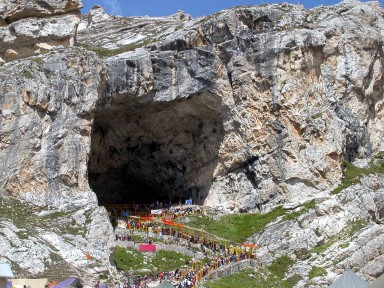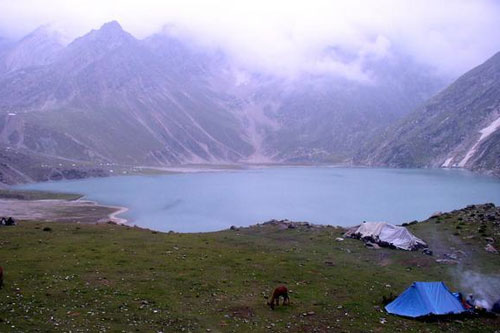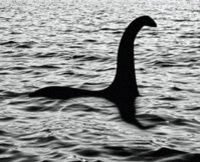Creatures of the Mind – Part One

The Holy Cave of Amarnath in Kashmir
In August 1975, I joined over ten thousand pilgrims, drawn from all parts of the Indian sub-continent, on the annual pilgrimage to the holy cave of Amarnath. This cave is situated at a height of 12,730 feet (3880 metres) in the western Himalayas of Kashmir, and lies at the head of a narrow valley, scoured by receding glaciers.
The cave itself is a huge vault of rock, open to the valley, which retreats some fifty feet (15 metres) into the face of the mountain. A trickle of water emerges from the rear of the cavern which freezes once it is exposed to the frigid air. As it freezes, it forms a column of ice set upon a natural pedestal of rock.
Since this column of ice is reminiscent of a lingam, a vertical pillar of stone which is used throughout India to symbolise the Absolute, it is revered as a natural manifestation of this cosmic principle. This lingam, which rises and wanes as the flow of water increases or decreases, has drawn pilgrims to this revered cave for more than two thousand years.
The four-day pilgrimage to the cave starts from the Kashmiri hamlet of Pahlgam in the Lidder valley and proceeds, in a series of daily stages, to the cave itself. The enormous throng of pilgrims, ranging from naked sadhus to rich ladies of society carried in sumptuous palanquins, forms a colourful serpent of humanity that sinuously winds its way over the snow-fields, rivers and precipitous ridges that mark the pathway to the cave.
On the morning of the fourth day, I had risen in the pre-dawn darkness and washed myself, as is the custom, in the freezing waters of the Pantsatarni stream, before making my way up the rocky defile to the cave.
Glad as I was to have reached my goal, the surging tide of humanity that pressed into the mouth of the cave made the last few steps to the lingam a terrifying experience. I feared that I might well terminate my pilgrimage as a crushed offering to Siva, the Hindu God of destruction.
It was with considerable relief that I found myself outside again in the crisp Himalayan air, and began the long trek back to Pahlgam. Some hours later, as I was negotiating a narrow path high above a glacial lake, my attention was drawn to a commotion among the sadhus in front of me. They were gesticulating enthusiastically, and pointing down to the lake, crying “Naga! Naga!”
As I looked down towards the water some five hundred feet (150 metres) below, I could see an enormous disturbance in the middle of the lake. A large creature was moving at considerable speed through the water, leaving in its wake a series of V-shaped waves.
Although at that distance I could not make out the nature of the creature, it was clearly too large to be any form of duck or goose. It seemed rather as if a horse was surging powerfully through the water. I watched the creature for perhaps a minute or so before it disappeared beneath the surface of the lake.
To the watching pilgrims this was undoubtedly the naga, or serpent from which the lake itself, Sheshiram Nag, had derived its name. The sadhus regarded the sight as an omen of good fortune, and I counted myself duly blessed by this unexpected vision.
Yet my curiosity was piqued by this unusual spectacle, and I later tried to establish just what sort of creature could have been swimming in such inhospitable conditions on that day in August.

Sheshnag Lake near the Amarnath Cave
Sheshiram Nag, or Sheshnag as it is more commonly known, is a solitary tarn lying in a depression surrounded by mountain peaks. The lake lies at an elevation of 11,700 feet (3566 metres), with its overlooking ridges soaring to about 16,000 feet (4877 metres).
The lake, which is silted up on its western flank, is fed by two small glaciers. For almost nine months of the year it is completely frozen, and subject to the harsh conditions which characterise the high Himalayas. It is extremely unlikely that sufficient sources of nutrition would exist in the lake to support a creature of the size I had seen.
I was certain that the creature was not a horse or mountain pony, for it moved through the water with a snake-like motion, far faster than any four-legged creature could have managed under the circumstances. I finally had to confess that what I had seen remained a mystery, and that perhaps I really had been granted a view of the serpent God.
In the course of the last century, however, strange serpentine creatures have been seen in numerous lakes around the world. Similar tales have been recounted by thousands of witnesses who professed to be just as baffled as I had been. These strange lake-bound creatures continue to be reported every year, much to the delight of avid monster-watchers, and editors of the sensational weekly magazines.
In October 1974, Walter Wojewodzic saw something which he did not expect or recognise in the waters of Lake Champlain in New York State.
“We were out duck hunting,” he later told reporters, “and we were pulling the boat ashore when I see this thing out in the bay, Bulwagga Bay. A great big thing with three giant black humps. It thrashed around for a good minute or so. Had to be 40, 50 feet (10-20 metres) long. Then it went under water and the wake, when it splashed on shore, looked like a yacht just went under.” 1
Wojewodzic’s weird encounter became yet another sighting of “Champ” the legendary lake monster of Lake Champlain. To date, over two hundred people claim to have witnessed something strange in the waters of this lake.
On May 31, 1982, Robert Frew was enjoying a meal with his family and a few friends, while holidaying at his house on Love Point, overlooking Chesapeake Bay on the eastern seaboard of the United States. His attention was suddenly drawn to a large object that was moving against the tide, about one hundred feet (30 metres) offshore.
Fred examined the object closely through binoculars, and saw a sinuous, humped creature, over twenty foot (6 metres) long, swimming lazily in the sea. While his family and friends kept watch on this creature, Frew grabbed his video camera and taped a three minute record of its movements. Frew’s videotape was considered by many to be hard evidence of yet another well-known monster of the region, known as “Chessie”. 2
Early one morning in June, 1982, police officer Kris Beebe happened to be water-skiing along the surface of Lake Tahoe, situated on the border between the American states of Nevada and California.
After skiing about half way across the lake, Beebe dropped into the water to rest. As he was bobbing in the early morning swell, a black, slimy shape broke the surface of the water about twenty-five feet (7.6 metres) away from him.
Beebe yelled to his friend and fellow policeman Jerry Jones, who quickly brought the speedboat around. As he did so the creature suddenly re-appeared. Thoroughly alarmed by this unusual spectacle, Jones revved up the motor, and Beebe rose up on his skis and sped away.
Beebe later told members of the press, “We saw it. We didn’t think we saw it; we saw it. It wasn’t threatening us. It was just gliding right past us. Scared? I believe I went into a state of shock. We checked into everything – dives, subs, everything – and we’re convinced it was some very, very large creature.” 3
On the other side of the Atlantic, equally enigmatic creatures were being observed in inland lakes. In the four mile (6.4 km) long Bala lake, known by its Welsh name of Llyn Tegid, a strange creature that had been dubbed “Teggie” was frightening local residents.
Lake warden Dewi Bowen claimed to have seen this strange aquatic monster himself, and described it as looking “a bit like a crocodile”. Other local fishermen had also spotted the creature. Said Bowen, “It scared the living daylights out of them.” 4
In 1954, a young Irish girl by the name of Georgina Carberry was out fishing with three of her friends on Lough Fadda, situated in County Galway, Ireland. Having caught several trout, the girls pulled their boat to the shore, and the four of them were enjoying a tea break, when they noticed something that looked at first like a man swimming in the water.
As it drew closer they realized that it was like nothing they had ever seen before. Georgina described it as a “wormy” creature with a huge mouth. Its head stood high above the water on a long neck. As the creature moved up the lake, Georgina saw two humps appear out of the water behind the head. As it dived around a rock she could see a forked tail.
The sudden appearance of this alarming monster caused Carberry to have nightmares for weeks afterwards. Yet what was surprising about this sighting was that Lough Fadda was a mere 1.5 miles (2.4 kilometres) long, and only six hundred yards (550 metres) at its widest point. The size of the lake seemed hardly capable of supporting so large a creature. 5
Even more startling was the strange sighting of Irish farmer Stephen Coyne in Lough Nahooin, County Galway, on February 22, 1968. Coyne was gathering peat at the lakeside at the time, accompanied by his eight-year old son and their dog, when he saw a black object in the water.
Thinking that it was his dog he whistled at it, but was surprised to find that his dog came running up to him from behind. The object moved slowly closer until it came to within ten yards (9 metres) of where he was standing. Coyne described it as about twelve feet (3.5 metres) long, black and hairless, with an eel-like texture to its skin. Its neck was pole-like and about twelve inches (30 centimetres) in diameter.
The mouth of the creature was pale, and it had two “horns” on top of its head. This eel-like monster had selected an even more improbable habitat in which to survive, since Lough Nahooin is only about one hundred yards (90 metres) long, eighty yards (73 metres) wide, and twenty-three feet (7 metres) deep.
Yet when heavy polystyrene nets were drawn across the entire area of this lake in July 1968, no trace of any eel like creature could be found. 6

“Nessie” the famous Loch Ness monster
Undoubtedly the best known of all lake monsters is to be found across the Irish Sea, in the dark waters of Loch Ness, Scotland. “Nessie”, as the beast has come to be called, was first reputed to have been seen by St. Columba, in the year 565 A.D.
In recent years numerous investigators have focused upon Loch Ness in an effort to determine the nature and origin of this elusive creature. Photographic surveillance has been conducted, both from the shore as well as under water, and extensive sonar recordings have been made in the waters of the loch.
In one exotic experiment, two engineers from Rochester, New York, Rikki Razdan and Alan Kielar, deployed sonar transducer devices that were designed to fire tiny biopsy harpoons that would be electrically triggered when a large creature swam within range. Razdan and Kielar hoped by these means to acquire small samples of the creature’s skin, which could then be subjected to scientific analysis.
Alas “Nessie” did not oblige. Apart from enigmatic photographs, and odd sonar results, no convincing evidence has yet been produced to support the existence of a large underwater creature living in the reaches of the loch. However, people still claim to see “Nessie”, and the record of visual sightings continues to grow from year to year.
Although “Nessie” can perhaps claim pride of place among lake monsters in terms of media coverage, it is but a single example among a large number of strange aquatic creatures reported from around the world.
Apart from “Nessie” in Loch Ness, Scotland also boasts a creature known as “Morag”, that is reported to exist in Loch Morar. Other reports have originated from Loch Assynt and Loch Arkaig.
We have already noted the existence of “Teggie” in Llyn Tegid, Wales. Irish lake monster reports have come from every corner of that island, including such lakes as Lough Muck in County Donegal, Lough Auna in Limerick, Lough Attariff in Cork, Lough Brin in Kerry, Lough Derrylea and Lough Crolan in Connemara, and Loughs Dubh, Fadda, Nahooin, Abisdealy and Shanakeever in County Galway.
Chesapeake Bay has its “Chessie” and Lake Champlain its “Champ”. In Canada, even these notables are dwarfed by the popularity of “Manipogo” in Lake Manitoba, and “Ogopogo” in Okanagan Lake, British Columbia, to say nothing of “Igopago”, who resides in Simcoe Lake, Ontario. Lake Utopia in New Brunswick and lake Pohenegamook in Quebec are also proud hosts of these weird eel-like creatures.
In America, lake monsters have been reported from Bear Lake, Utah; Folsom lake, California; Walgon Lake, Nebraska; Payette Lake, Idaho; Flathead Lake, Montana; Iliamna Lake, Alaska; Silver Lake, New York; and Red Cedar Lake, Pewaukee Lake and Elkhart lake in Wisconsin.
In the People’s Republic of the Congo in Africa, a creature known locally as “Mokele-Mbembe” graces Lake Tele, and “Lukwata” is said to a resident of Lake Victoria in East Africa. Strange serpentine creatures have also been reported from Lake Suldal and Lake Storsjo in Scandinavia.
If there still remains some prehistoric species, hitherto unknown to biologists, that lurks within the water-courses of the world, it has shown an amazing capacity to survive in lakes large and small, in every part of the planet.
Not only has this species taken a liking to the temperate regions of the globe, but it is also partial to the tropics, and seems capable of surviving at high altitudes in trans-Himalayan lakes which are burdened with ice for the major part of the year.
Lake monsters must be extraordinarily versatile creatures, as their descriptions seem to vary, not only from region to region, but also from one sighting to another in the identical lake.
Furthermore, these creatures seem capable not only of surviving, but of thriving in the midst of inhabited communities, seemingly resistant to the depredation of chemical effluent and pollution, all the while covering their tracks and leaving no signs of their activities or passing.
It is little wonder, therefore, that the majority of scientists have come to regard these creatures as apocryphal, and the men and women who report them as deluded, where they are not outright frauds. Until the carcass of one of these strange creatures can be produced for laboratory analysis, scientists prefer to reject the authenticity of these sightings.
But if strange things are going on in the watery glens of our planet, something even stranger seems to be happening in the mountainous and forested regions of the earth.
(Continued in Part Two)
References:
1 “Holiday Press“, Binghampton, New York, December 26, 1983.
2 “Sun“, Baltimore, Maryland, July 11, 1982.
3 “Bee“, Sacramento, California, July 31, 1983.
4 “Courier and Advertiser“, Dundee, Scotland, August 19, 1983.
5 Janet and Colin Bord, “Irish Lake Monsters“, in “Creatures from Elsewhere“, edited by Peter Brookesmith, Orbis, London, 1984, p. 81.
6 Ibid, pp. 84-86.




